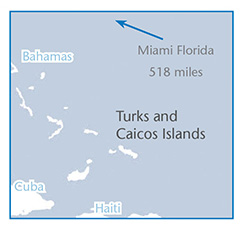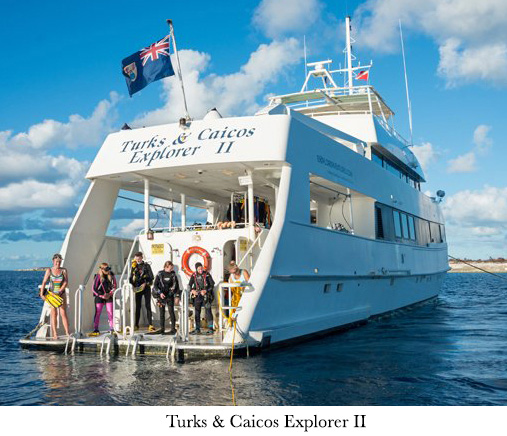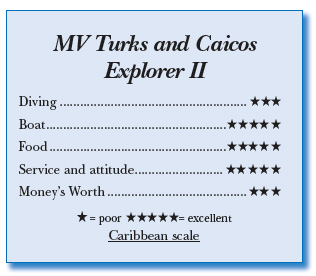Turks and Caicos Explorer IIContents of this Issue: MV Infiniti, Andaman Sea, India Fifty-Nine Missing Fish Species What Happened to Palau’s Jellyfish? Yes, Sexism in the Diving Industry Exists $25 Million Lawsuit on Rebreather Death Snorkels: Love ’em or Hate ’em? Sport Divers Discover 4th Century Treasures Editorial Office: Ben Davison Publisher and Editor Undercurrent 3020 Bridgeway, Suite 102 Sausalito, CA 94965 great boat, great food, but degraded reefs from the June, 2016 issue of Undercurrent
Last year, I enjoyed a trip aboard the T&C Explorer II enough to return; the boat was very comfortable, and though the food was pretty bad, it was clearly a quality operation. The vessel is 124 feet long, with two king bed VIP cabins on the upper deck, five doubles with comfortable beds on the main deck, and three bunk bed cabins below for a total of 20 divers. Every type of late model TV and video is in the main salon. On last year's trip, sponsored by REEF, we explored the virtually uninhabited Bahamas islands of Lesser and Greater Inagua. The reefs I saw there were pristine, and I wanted to see a more conventional itinerary starting to the northwest, in Providenciales (Provo). I came away still impressed with the boat, but with misgivings about the health of the reefs. Most dives featured a couple reef sharks, sometimes half-a-dozen. I don't know about you, but I am never bored when there's a shark in the water. But having dived here some 30 years ago, I was aware that things had changed. Maybe it's not fair to compare places so many years apart; after all, people who haven't seen "the old Caribbean" are often happy divers in these waters, as most aboard this trip were. I learned to dive off Provo in the mid-1980s, and it was lush and pristine. The diving I've seen in and around Provo since then has declined, based on at least fifteen trips between the 1980s and 2005. Grace Bay was rapidly transformed into a series of high-rise hotels, whose construction and sewage runoff killed the reefs. So when I booked this trip, I looked forward to seeing better reefs the farther we got from Grace Bay. However, when I saw algae often covering the patchy reefs far beyond Grace Bay, I did some research.
The Explorer II runs two itineraries, one that starts in Provo and travels to Northwest Point, West Caicos, and French Cay, and another starting in Grand Turk. This trip was the Provo itinerary. Engineer Ross Burk proudly showed me around the engine room. Two new 500 HP diesels can put out up to 650 HP, all computer-controlled. Two reverse osmosis water systems produce 5000 gallons per day. The room was as spotless as an engine room could be. We made our dives from the main deck, either with a giant stride and a five-foot drop or from the transom, a five-inch drop. There's a head on the dive deck, two hot showers on the transom, and the clean camera table had a dedicated air nozzle for drying gear. The crew did indeed emphasize safety; before embarking, we had a drill meeting at the muster station and donned life vests. This boat is known for swinging rather wildly on its mooring in a modified figure-8, but in fact, it isn't that different from a conventional V-hull's swing and scope. I remember Mel Brooks' "Two Thousand Year Old Man" and his advice on how to live a long life: "Never run for a bus; there's always another coming." The same applies to a swinging boat. The boat has a rigid inflatable dinghy that can pick up a stranded diver in a pinch as well.
And then there's the food. After years afloat, cook Stanley was on leave. While last year the food was barely acceptable at a junior high school cafeteria, this time, the replacement chef, Jim P. McCullough, ran a floating high-end restaurant. The crew grumbled that they would get fat! Every day began with a hot breakfast, including omelets, huevos rancheros, eggs Benedict with salmon or ham, banana pancakes with sausage, and French toast. Mid-morning snacks were baked treats like white chocolate chunk or butterscotch almond cookies or lemon poppy seed muffins. Lunches might be enchiladas, chicken and avocado wraps, hamburgers, and kebabs grilled on the upper-deck barbecue. Dinners featured mahi mahi, ginger chicken, eggplant parmesan, or slow-cooked ribs (so tasty that the European guests agreed this was American food at its best). Side dishes like cauliflower with garlic, carrots with dill butter, quinoa, and Szechuan cabbage kept plates full. And both meals included a big salad. Chef Jim's desserts should be controlled substances, particularly his bread pudding with rum sauce and boca negra, and a death-by-chocolate cake. It helps that Captain Jean-Francois Chabot is himself a passionate cook. He loved the grill and baked mouth-watering focaccia. Yes, I have gone on about the food, but that's because it was outstanding, especially in light of the defrosted-then-burned offerings of Stanley. And if dives become disappointing, great food will take the bad taste from your mouth. Thanks to north swells, our diving was confined to the reefs around West Caicos and French Cay. First up was Yankee Town off West Caicos, offering a wall with nice black corals and a few reef sharks, though a lot of sand. The Gully, nearby, had a steep wall with a swim-thru and sandy shallows dotted with coral heads. My buddy found a flying gurnard in the sand, and we viewed some reef sharks, Nassau grouper, and barracudas. Yet my log also notes that this was "a dull dive" because of the patchiness of coral cover and the relative paucity of fish. However, this was not due to the dive staff, particularly Jo Swannell, whose dive briefings were often in costume (Cyndi Lauper for Rock Garden Interlude -- rock, get it? -- Elvis for Rock and Roll) and my favorite, Tutu Tuesday, when six lucky divers wore tutus over their wetsuits. The other primary divemaster, Joe Lamontagne, is a marine biologist and made sure that each briefing included tips on finding creatures or fish. Buddy diving was fine, or you could go with the guide; certified solo divers could rent additional tanks and go it alone. April water temperatures ranged from 77°-79°F, and I was comfy in my 7mm, although less wimpy divers were fine in 3-5mm suits. In the summer, water is always much warmer. At Spanish Anchor off West Caicos, fish were relatively few (though most dives offered a reef shark or two); Rock Garden Interlude was the fishiest of the West Caicos sites. The wall encouraged currents, which brought schools of horse eye and crevalle jacks, Atlantic spadefish, various grouper, and teeming schools of blue chromis and Creole wrasse. Fish were so much denser than all previous dives that my buddy and I exchanged high-fives instead of the yawns we had exchanged earlier. Ironically, the night dive at this site was notable largely for teeming bloodworms, which obscured the view of lobsters and hunting jacks. Some night divers even found bloodworms in their camera gear. If you haven't seen a bloodworm, they are pretty disgusting little worms that feed at night, attracted to lights, and whose entertainment value to divers is to feed them to coral polyps.
Yet overall, my anecdotal view was that the numbers of fish were fewer than ever, and the condition of the corals was degraded. A lot of the yellow-brown algae covered what had been live coral, and there was more filamentous red algae than I like to see. The guests were a mix of Americans, Canadians, and Europeans, and I wondered if the Europeans, who came so far, were happy with the diving, though none complained. Do you know the saying that "there's a jerk on every boat, and if you don't know who it is, it's you?" Well, one diver distinguished himself by wearing tank tops with reactionary conservative political slogans, like "Obama Can't Take THESE Guns" (with arrows pointing to his arms). My buddy had to explain to the Italian divers what the shirt meant; when they understood the slang for biceps and the passion for firearms, as well as the disrespect to the President, they rolled their eyes. This diver couldn't restrain himself from loud tirades about "the worst President EVER" (clearly, this thoughtless nonscholar had never heard of consensus presidential bottom dwellers James Buchanan and Franklin Pierce, both Democrats he would be delighted to know) and buttonholed the American divers to demand to know for whom they were voting. My mother never let us talk about politics at the table or in social settings, but clearly this diver's mother felt differently. It was unpleasant, and most of us avoided contact with the in-your-face fellow. Living on a boat makes a live-and-let-live attitude essential. If you dived these waters in earlier years, you might find the reefs less lush, although the boat is terrific. Compared with areas with long-standing reef conservation, like Bonaire, it seems the Turks and Caicos, at least this itinerary, have come to the conservation party a little late. Anthropogenic (or humaninduced) effects abound on its reefs. -A.E.L. Our undercover diver's bio: A.E.L. loves to dive (and to eat!), and does around 150-180 dives a year all over the world. Diving since the mid-1980s has turned A.E.L. into a passionate marine conservationist and maybe a fussbudget on that front.
|

I want to get all the stories! Tell me how I can become an Undercurrent Online Member and get online access to all the articles of Undercurrent as well as thousands of first hand reports on dive operations world-wide
| Home | Online Members Area | My Account |
Login
|
Join
|
| Travel Index |
Dive Resort & Liveaboard Reviews
|
Featured Reports
|
Recent
Issues
|
Back Issues
|
|
Dive Gear
Index
|
Health/Safety Index
|
Environment & Misc.
Index
|
Seasonal Planner
|
Blogs
|
Free Articles
|
Book Picks
|
News
|
|
Special Offers
|
RSS
|
FAQ
|
About Us
|
Contact Us
|
Links
|
3020 Bridgeway, Ste 102, Sausalito, Ca 94965
All rights reserved.

 According to a recent study published by Alan Logan and Kathleen Sullivan Sealey, "The Reefs of the Turks and Caicos Islands" (
According to a recent study published by Alan Logan and Kathleen Sullivan Sealey, "The Reefs of the Turks and Caicos Islands" (
 Elephant Ear Canyon boasted handsome
underwater topography as well as eponymous
sponges. When we moved to French Cay, fishiness ticked up, including more reef
sharks, the occasional Cubera snapper, and clouds of wrasse and chromis. There
was still too much algae on the substrate, yet the fish life seemed denser. At
Rock and Roll, Jo pointed out a male yellow-headed jawfish incubating eggs in its
mouth, while I spotted a handsome large hawksbill turtle swimming slowly over the
edge of the reef. At Sand Spit South, southeast of French Cay, my buddy found two
enormous nurse sharks snuggled together under one of the many shallow coral heads
that dotted the area. Other dives included hogfish, queen triggers, rock beauties,
queen, gray, and French angelfishes, and small swarms of juveniles.
Elephant Ear Canyon boasted handsome
underwater topography as well as eponymous
sponges. When we moved to French Cay, fishiness ticked up, including more reef
sharks, the occasional Cubera snapper, and clouds of wrasse and chromis. There
was still too much algae on the substrate, yet the fish life seemed denser. At
Rock and Roll, Jo pointed out a male yellow-headed jawfish incubating eggs in its
mouth, while I spotted a handsome large hawksbill turtle swimming slowly over the
edge of the reef. At Sand Spit South, southeast of French Cay, my buddy found two
enormous nurse sharks snuggled together under one of the many shallow coral heads
that dotted the area. Other dives included hogfish, queen triggers, rock beauties,
queen, gray, and French angelfishes, and small swarms of juveniles. Divers Compass: A typical trip in a main deck cabin is usually around $2495, though the company runs special trips and promotions; nitrox was usually 31%-32% and a flat fee of $130 for the week; the crew can make small repairs and has backup and rental gear available. . . . . Provo has a hyperbaric chamber that can accommodate multiple divers. . . . . Several airlines fly here directly from the U.S. and Canada. British Airways flies from Heathrow. . . . .The Grand Turk itinerary requires a plane transfer from Provo . . . .Tips can be left on your credit card or in cash, and there's no charge for booze (which includes call brand spirits, drinkable wines, and good beers), but a drink signals you are done diving for the day.
Divers Compass: A typical trip in a main deck cabin is usually around $2495, though the company runs special trips and promotions; nitrox was usually 31%-32% and a flat fee of $130 for the week; the crew can make small repairs and has backup and rental gear available. . . . . Provo has a hyperbaric chamber that can accommodate multiple divers. . . . . Several airlines fly here directly from the U.S. and Canada. British Airways flies from Heathrow. . . . .The Grand Turk itinerary requires a plane transfer from Provo . . . .Tips can be left on your credit card or in cash, and there's no charge for booze (which includes call brand spirits, drinkable wines, and good beers), but a drink signals you are done diving for the day.